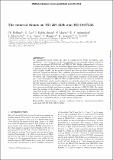Files in this item
The mineral clouds on HD 209458b and HD 189733b
Item metadata
| dc.contributor.author | Helling, Christiane | |
| dc.contributor.author | Lee, G. | |
| dc.contributor.author | Dobbs-Dixon, I. | |
| dc.contributor.author | Mayne, N. | |
| dc.contributor.author | Amundsen, D. S. | |
| dc.contributor.author | Khaimova, J. | |
| dc.contributor.author | Unger, A. A. | |
| dc.contributor.author | Manners, J. | |
| dc.contributor.author | Acreman, D. | |
| dc.contributor.author | Smith, C. | |
| dc.date.accessioned | 2016-04-29T14:30:09Z | |
| dc.date.available | 2016-04-29T14:30:09Z | |
| dc.date.issued | 2016-07-21 | |
| dc.identifier | 242260820 | |
| dc.identifier | 31646a5c-e2c5-43f6-9d73-4321f0cbe00e | |
| dc.identifier | 84979052935 | |
| dc.identifier | 000379835200058 | |
| dc.identifier.citation | Helling , C , Lee , G , Dobbs-Dixon , I , Mayne , N , Amundsen , D S , Khaimova , J , Unger , A A , Manners , J , Acreman , D & Smith , C 2016 , ' The mineral clouds on HD 209458b and HD 189733b ' , Monthly Notices of the Royal Astronomical Society , vol. 460 , no. 1 , pp. 855-883 . https://doi.org/10.1093/mnras/stw662 | en |
| dc.identifier.issn | 0035-8711 | |
| dc.identifier.other | RIS: urn:B51D80E30D07ACFE9396D31341836F8C | |
| dc.identifier.uri | https://hdl.handle.net/10023/8704 | |
| dc.description | We highlight financial support of the European Community under the FP7 by the ERC starting grant 257431 and by an ERC advanced grant 247060. JK acknowledges the Rosen fellowship from the Brooklyn College New York, US. | en |
| dc.description.abstract | 3D atmosphere model results are used to comparatively study the kinetic, non-equilibrium cloud formation in the atmospheres of two example planets guided by the giant gas planets HD 209 458b and HD 189 733b. Rather independently of hydrodynamic model differences, our cloud modelling suggests that both planets are covered in mineral clouds throughout the entire modelling domain. Both planets harbour chemically complex clouds that are made of mineral particles that have a height-dependent material composition and size. The remaining gas-phase element abundances strongly effects the molecular abundances of the atmosphere in the cloud forming regions. Hydrocarbon and cyanopolyyne molecules can be rather abundant in the inner, dense part of the atmospheres of HD 189 733b and HD 209 458b. No one value for metallicity and the C/O ratio can be used to describe an extrasolar planet. Our results concerning the presence and location of water in relation to the clouds explain some of the observed discrepancies between the two planets. In HD 189 733b, strong water features have been reported while such features appear less strong for HD 209 458b. By considering the location of the clouds in the two atmospheres, we see that obscuring clouds exist high in the atmosphere of HD 209 458b, but much deeper in HD 189 733b. We further conclude that the (self-imposed) degeneracy of cloud parameters in retrieval methods can only be lifted if the cloud formation processes are accurately modelled in contrast to prescribing them by independent parameters. | |
| dc.format.extent | 29 | |
| dc.format.extent | 5188425 | |
| dc.language.iso | eng | |
| dc.relation.ispartof | Monthly Notices of the Royal Astronomical Society | en |
| dc.subject | Astrochemistry | en |
| dc.subject | Opacity | en |
| dc.subject | Methods: numerical | en |
| dc.subject | Planets and satellites: individual: HD 189 733b, HD 209 458b | en |
| dc.subject | QB Astronomy | en |
| dc.subject | QC Physics | en |
| dc.subject | NDAS | en |
| dc.subject.lcc | QB | en |
| dc.subject.lcc | QC | en |
| dc.title | The mineral clouds on HD 209458b and HD 189733b | en |
| dc.type | Journal article | en |
| dc.contributor.sponsor | European Research Council | en |
| dc.contributor.institution | University of St Andrews. School of Physics and Astronomy | en |
| dc.identifier.doi | https://doi.org/10.1093/mnras/stw662 | |
| dc.description.status | Peer reviewed | en |
| dc.identifier.grantnumber | 257431 257431 | en |
This item appears in the following Collection(s)
Items in the St Andrews Research Repository are protected by copyright, with all rights reserved, unless otherwise indicated.

